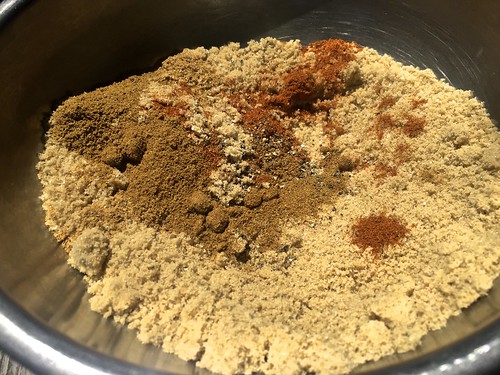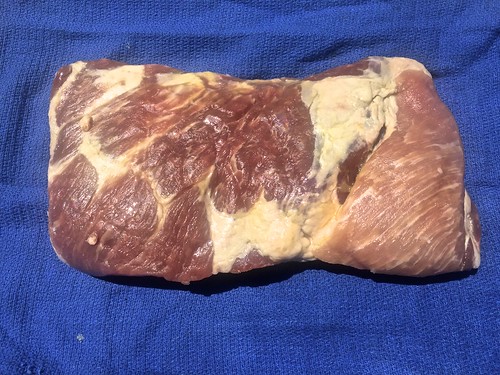I love soup. A cold soup in summer and a hot soup in winter are wonderful comfort foods. The best soups for me are ones that not only nourish but delight with layered flavors. In summer a light and spicy watermelon-gazpacho takes the edge off soggy, sultry days. In cool weather, a satisfying soup of roasted squash is filling and refreshing.
With cooler weather approaching, a great many varieties of squash will be available in farmers markets. My favorite is the Japanese squash kabocha. A squat round squash with a flecked dark green outer skin, the flesh can be bright yellow or pumpkin orange. Similar to butternut squash, kabocha is sweeter and cooks more quickly.
I first enjoyed kabocha as light and crispy tempura at Yabu, a sushi bar in West Los Angeles. Included in an order was a sheet of seaweed, shrimp, shiso pepper, shiitake mushroom and kabocha. With only one slice of each to an order, my wife and I divided up the sampling but we always shared the sweet flavored kabocha.
Over the years, I tried preparing kabocha using different techniques. Boiling, steaming, roasting and deep frying. Boiled, the flesh absorbs too much water and becomes soggy. Deep frying is specific to tempura. Steaming softens the flesh. Roasting puts a crust on the outside.
I discovered that combining steaming and roasting created full-of-flavor, firm fleshed pieces. We serve steamed & roasted kabocha as a side dish to accompany grilled fish, chicken and meat. Cut into bite sized pieces, the kabocha is delicious added to soups, stews and braises. Pureed, kabocha creates a deliciously sweet and creamy soup.
For a pot-luck brunch at a friend's beach house, I decided to make kabocha soup. Still out of season locally, kabocha can usually be found in Asian, Latin and Persian markets.
To make a vegetarian/vegan soup, I used homemade vegetable stock. Homemade chicken stock can also be used because of its light flavor but I wouldn't use beef or seafood stock because they are too strong.
Homemade stock is much preferable to store bought because the flavors will be cleaner and the salt content will be much lower. We always have a good supply of homemade stocks in the freezer so I can make soup at a moment's notice.
Making vegetable stock is easy, with a little planning and one important kitchen tool: a food mill. Vegetable stock can be made with a variety of your favorite vegetables. Dice and simmer carrots, celery, onions and mushrooms for an hour with water until soft. Run the liquid and softened vegetables through a food mill to create a delicious stock with pulp, ideal for making soups and sauces.
An alternative method is the one I prefer. During the week I collect vegetable trimmings as I prepare salads and stir fries. I place them into a sealed bag in the freezer. When we have corn on the cob, we put the cobs in the freezer as well. Once there is a large amount collected, all the trimmings and cobs go into a large stock pot. I add enough water to cover and simmer uncovered for an hour or more until the stock has flavor. Then the trimmings, except the corn cobs, go into the food mill as described above. I freeze stock in 16 and 8 ounce sealed containers for times when I want to make a soup or a braise.
Richly Flavored Kabocha Squash Soup
If kabocha is not available, butternut and acorn squash are good substitutes. But they are not as sweet.
If shiitake mushrooms are not available, brown and portabella mushrooms are good substitutes.
The slow roasted tomatoes are easy to make. While you sleep or read or work around the house, the tomatoes cook in the 225 F oven. Slow roasting removes the tomato's water, concentrating the flavors, bringing out sweetness. After the tomatoes are removed from the oven and cooled, they can be refrigerated or frozen in an air tight container. Remove the paper thin skins before using. The skins aren't edible but they add a wonderful flavor to vegetable stock.
To puree the soup and create a creamy texture, use an immersion blender or a blender. I like the immersion blender because of the easy clean up. When blending, no need to remove all small vegetable bits. A bit of texture is good.
As a topping, homemade croutons or charred greens (escarole, spinach or kale) and onions are good.
Serves 4 (entree) or 8 (starter)
Time to prep: 30 minutes
Time to cook: 60 minutes plus 6 hours to make slow roasted Roma tomatoes
Total time: 90 minutes plus 6 hours to make slow roasted Roma tomatoes
Ingredients
2 large Roma tomatoes, washed, stem removed, cut in half from stem to tip
1 1/2 pound kabocha squash, washed, skin on, quartered from top to bottom, seeds and pulp removed and discarded
1 cup sliced mushrooms, preferably shiitake, washed, pat dried
1 medium and 1 small yellow onion, washed, root and stem removed, skin removed and discarded
2 cups kale leaves, washed, stems removed, finely cut
6 cups homemade stock, vegetable for vegan and vegetarian soup or chicken stock
1 cup escarole, spinach or kale, washed, finely shredded
2 tablespoons extra virgin olive oil
1 teaspoon kosher salt
1/4 teaspoon sea salt
1/8 teaspoon freshly ground black pepper
Pinch cayenne (optional)
Directions
Before you go to bed or while you are working around the house, preheat the oven to 225 F. Place the halved Roma tomatoes on a Silpat or parchment sheet on a baking sheet. Drizzle with olive oil. Place in the oven 5-6 hours. Remove when the tomatoes are still plump and they have reduced their size by half.
Remove tomatoes and allow to cool. If using immediately, remove the skins and discard or use to make vegetable stock. Finely chop the roasted flesh and reserve.
Place 2" water and kosher salt into the bottom of a large pot. Place a steamer basket into the pot with the quartered kabocha on top. Cover. Bring water to boil. Cook 10 minutes or until a pairing knife can be easily inserted into the flesh. Remove and cool.
Using a pairing knife, remove the kabocha skins and discard. Place the steamed kabocha on the Silpat or parchment sheet covered baking sheet. Drizzle with olive oil. Place into preheated 350 F oven. Cook 30 minutes. Remove and allow to cool.
Heat a tablespoon olive oil in a large pot. Sauté but not do not brown mushrooms, medium onion slices and kale. Cut roasted kabocha into quarter sized pieces and place into the pot. Add stock. Stir and simmer 30 minutes.
Heat a teaspoon olive oil in a small frying pan. Saute the sliced small onion and chopped escarole, spinach or kale until charred. Remove and reserve.
Taste soup. Adjust seasoning with sea salt and/or black pepper. Taste and add cayenne (optional).
Using an immersion blender or blender, puree soup until smooth allowing for some vegetable bits.
Serve hot with the charred escarole and onions sprinkled on top.

Watermelon Surprise, watermelon ice cubes in a vodka cocktail. Credit: Copyright 2016 David Latt
You love summer but not when it is uncomfortably hot. For relief, you could jump into the pool. Or, you could cut a thick slice of watermelon and let the sweet juices cool you down. Even better, you could fill a tall glass with a watermelon cocktail made with watermelon ice cubes and straight-from-the-freezer vodka and settle into the chaise lounge. You stir the ice cubes. Bits of watermelon juice break free. The crystal clear vodka turns pink. You sip, stir and eat a watermelon ice cube and suddenly you are not overheated any longer. Now, you are cool and happy.
The non-alcoholic version is as delicious. Fill a tall glass with watermelon ice cubes and pour in freshly made lemonade. Stir and enjoy.
The non-alcoholic version is as delicious. Fill a tall glass with watermelon ice cubes and pour in freshly made lemonade. Stir and enjoy.
Summertime and the livin’ is easy
Summer is good for watermelon. They grow quickly in the heat of the sun, producing fat, heavy fruit loaded with sweetness.
At the farmers market I was always told to use a hand to thump on the melon. When the sound was deep and resonant, the melon was ripe, ready to eat. If there is a farmer you frequent at your neighborhood market, ask for advice about a good melon that’s ready to eat.
Prices for watermelon vary greatly. At Asian and Latin markets, watermelon can sell for as little as 10 cents a pound. At upscale supermarkets and farmers markets, the prices can be significantly higher.
A melon is delicious at room temperature or ice cold. I like to chill the melon overnight in the refrigerator. Of course, the easiest way to eat watermelon is to use a sharp knife to cut out a thick slice.
But when I was in Zurich recently I met Olivier Rais, a talented chef who runs the bistro Rive Gauche in the iconic hotel Baur au Lac across the street from Lake Geneva. He had just returned from working with Tal Ronnen, the celebrated chef who created Crossroads Kitchen, an upscale Los Angeles restaurant devoted to vegan cuisine.
Rais made several vegan dishes for me to taste, one of which was a watermelon-gazpacho served in a glass.
I love watermelon but had never thought of extracting the juice. When I replicated his gazpacho at home, I had watermelon juice left over. Deciding to experiment, I reduced the juice in a sauce pan over a low flame. Once the juice cooled, I poured it into a mini-ice cube tray.


Watermelon ice cubes in an ice cube tray. Credit: Copyright 2016 David Latt
That night I added the ice cubes to vodka that we keep in the freezer. I dropped in an espresso spoon, settled into a chair and stirred my drink. After a few sips, I realized that I had stumbled onto an easy-to-make, deliciously refreshing cocktail. Summer’s perfect drink.
Serve the cocktail with an espresso or small spoon. One of the pleasures of the drink is stirring the ice cubes. As the ice cubes melt, the watermelon juice infuses the vodka. The mellow sweetness takes the edge off the vodka.
As you stir, the ice cubes crater and reduce by half. Use the spoon to scoop up the icy bits. In an effervescent moment, the softened ice cubes dissolve like pop rocks in your mouth.
Watermelon Surprise
Use any size plastic ice cube tray. The mini-trays that make 1” square ice cubes work well because the ice cubes melt easily. Use only unflavored premium vodka, and for non-alcoholic drinks, add the ice cubes to glasses of carbonated water or lemonade.
Prep time: 30 minutes
Freezer time: 1 hour or overnight depending on the temperature of the freezer
Total time: 1 hour 30 minutes or overnight and 30 minutes
Yield: 4 servings
Ingredients
1 (3-pound) watermelon, washed
8 ounces unflavored premium vodka
Directions
1. Place the vodka bottle in the freezer the night before serving.
2. Using a sharp knife, remove the rind from the watermelon. Discard.
3. Cut the melon into chunks, removing any seeds.
4. Place a food mill or a fine mesh strainer over a non-reactive bowl.
5. Press the watermelon chunks through the food mill or strainer, capturing all the juice in the bowl. Discard any pulp and seeds.
6. Pour the juice into a sauce pan over low heat. Reduce volume by 30%. Remove from stove. Allow to cool.
7. Pour the reduced juice into the ice cube tray.
8. Place into freezer.
9. Just before serving, pour 1½ ounces ice cold vodka into each glass. Place 5 to 6 ice cubes into each glass.
10. Serve with an espresso or small spoon.
Main photo: Watermelon Surprise, watermelon ice cubes in a vodka cocktail. Credit: Copyright 2016 David Latt











































